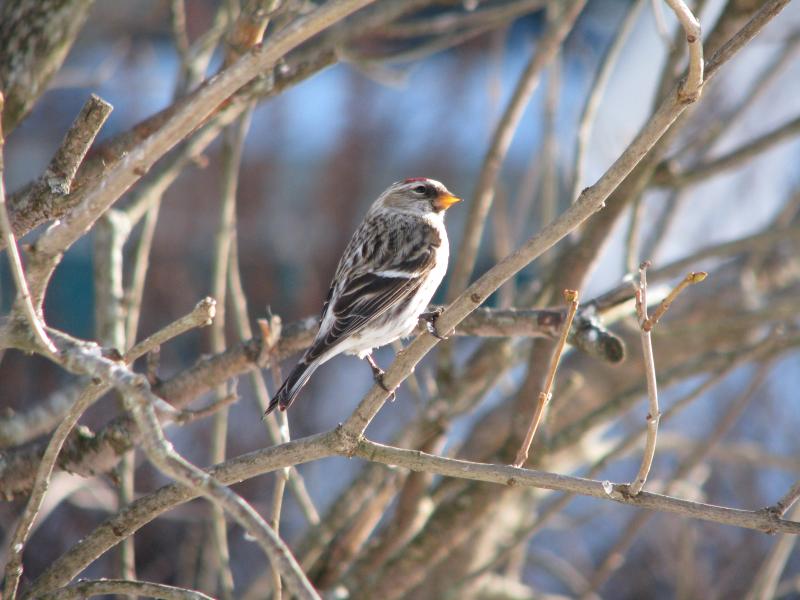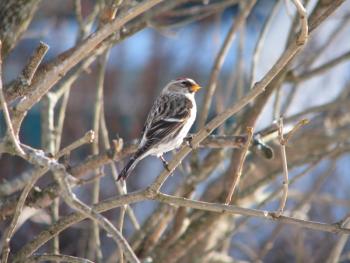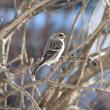A Birder Holiday
For birders in the eastern U.S. in particular, it is as eagerly anticipated as Christmas morning is to so many youngsters. But it happens at best only every two years.
We are talking about the so-called “irruptions” or “invasions” of winter finches originating largely from the Boreal Forest region of Canada and Alaska. The species birders usually consider talking of winter finch are pine siskins, common and hoary redpolls, evening grosbeaks, pine grosbeaks and sometimes white-winged crossbills. Except for the two redpoll species, all of these birds reach the southern limit of their regular breeding distribution in Maine, New Hampshire, and Vermont, but they have a vast range across Canada and Alaska. They are all virtually exclusively seed eaters, although pine grosbeaks will also consume fruits and berries.
This year is already looking like one of those winter finch invasion years. Birders from Maine have been reporting both evening grosbeaks and pine siskins for the last several weeks. Our own feeders were visited by a flock of six pine siskins just a few days ago, and they (or at least some pine siskins) have continued visiting daily since then. Pine siskins seem to have had an early push southward across most of the eastern U.S. as, according to eBird, individuals have been found even as far south as the Panhandle of Florida. In October, one was even found way out on the isolated outpost of Bermuda!
We haven’t been lucky enough yet to have evening grosbeaks visit our yard this year but many Maine birders have. In fact, this year evening grosbeaks have already been reported as far south as Virginia. Some of us remember the massive flocks of sometimes hundreds of evening grosbeaks that were regular winter visitors in Maine as late as the 1970s and early 1980s. Unfortunately, the species began a steep decline in numbers soon after that and has registered a more than 80% drop in abundance since those times.
While both evening grosbeaks and pine siskins inhabit the southern portion of the Boreal Forest region of Canada (Alaska, too, in the case of pine siskins, but not evening grosbeaks), pine grosbeaks nest largely in the northern half of the Boreal Forest of Canada and Alaska, occasionally breeding south to Maine and the Maritimes. Common redpolls are more northerly, their breeding range encompassing the northern Boreal Forest region northward into the Arctic.
Common redpolls, similar in size and shape to pine siskins, are much whiter, with a red patch on the front of the head and a yellow bill. They have begun arriving in Maine with a handful of reports over the last few weeks. Indeed, sightings have come from as far south as Cape May, New Jersey.
One of our favorites among the winter finches are the pine grosbeaks with their propensity for feeding in crab apple trees, their often very tame and confiding behavior, and their mellow, sweet calls. We just heard a few days ago of the first report of these birds in the state, though eBird shows lots of them just to our North in southern Quebec, so we will be watching and listening closely for them.
As we await the eagerly anticipated birder’s “holiday” of this year’s winter finch invasion, we join with millions of birders from across the U.S. and Canada to celebrate the Year of the Bird. This designation commemorates the historic treaty and legislation that came to pass a hundred years ago: the Migratory Bird Treaty and the U.S. Migratory Bird Treaty Act. This legislation has been crucial to maintaining healthy populations of winter finches and all of our migratory birds.
Jeffrey V. Wells, Ph.D., is a Fellow of the Cornell Lab of Ornithology. Dr. Wells is one of the nation's leading bird experts and conservation biologists and author of the “Birder’s Conservation Handbook.” His grandfather, the late John Chase, was a columnist for the Boothbay Register for many years. Allison Childs Wells, formerly of the Cornell Lab of Ornithology, is a senior director at the Natural Resources Council of Maine, a nonprofit membership organization working statewide to protect the nature of Maine. Both are widely published natural history writers and are the authors of the popular book, “Maine’s Favorite Birds” (Tilbury House) and the just-released “Birds of Aruba, Bonaire, and Curaçao” from Cornell University Press.
Event Date
Address
United States

























